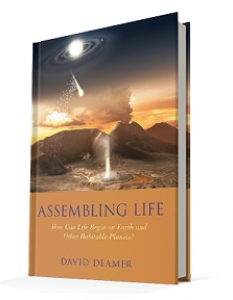The question that forms the subtitle of this book – How can life begin on Earth and other habitable planets? – is one that has challenged scientists for many years. In this volume, the author, a research professor of biomolecular engineering, challenges the consensus that life began in the ocean and presents an alternative scenario, based on his research, in which life began in freshwater hot springs.
Although the author has “tried to make this book interesting and readable”, he admits that it is more of an academic monograph than popular text. As such, each chapter ends with references, there is a bibliography and an index, and the font is small and somewhat dense. It will, nevertheless, appeal to those with an interest in the genesis of life on Earth and the prospects for life on other planets (which should be all of us).
According to Deamer, organic compounds delivered to Earth’s surface by meteorites could accumulate in small pools, in which a film of extremely concentrated compounds forms through evaporation. “If the compounds can react, this is where it happens”, says Deamer, quoting his field and laboratory experiments. “To my knowledge, no one else working on the origin of life has ventured out of the lab to see if their experiments actually work in conditions like those of the prebiotic Earth”.
The debate is unlikely to be concluded anytime soon, but this volume represents an interesting part of the discussion. It is illustrated with black and white line drawings and has a 24-page colour insert.











